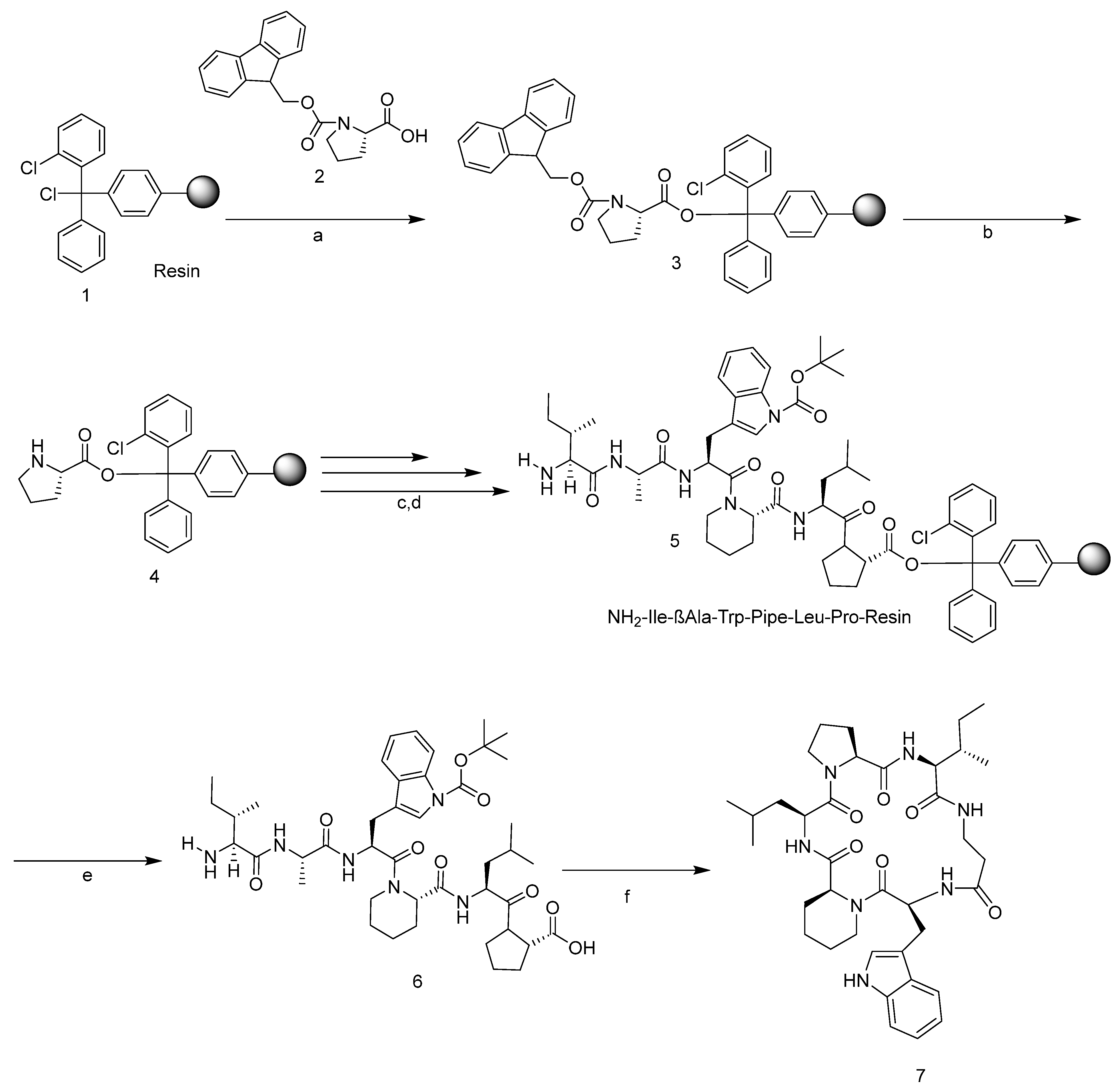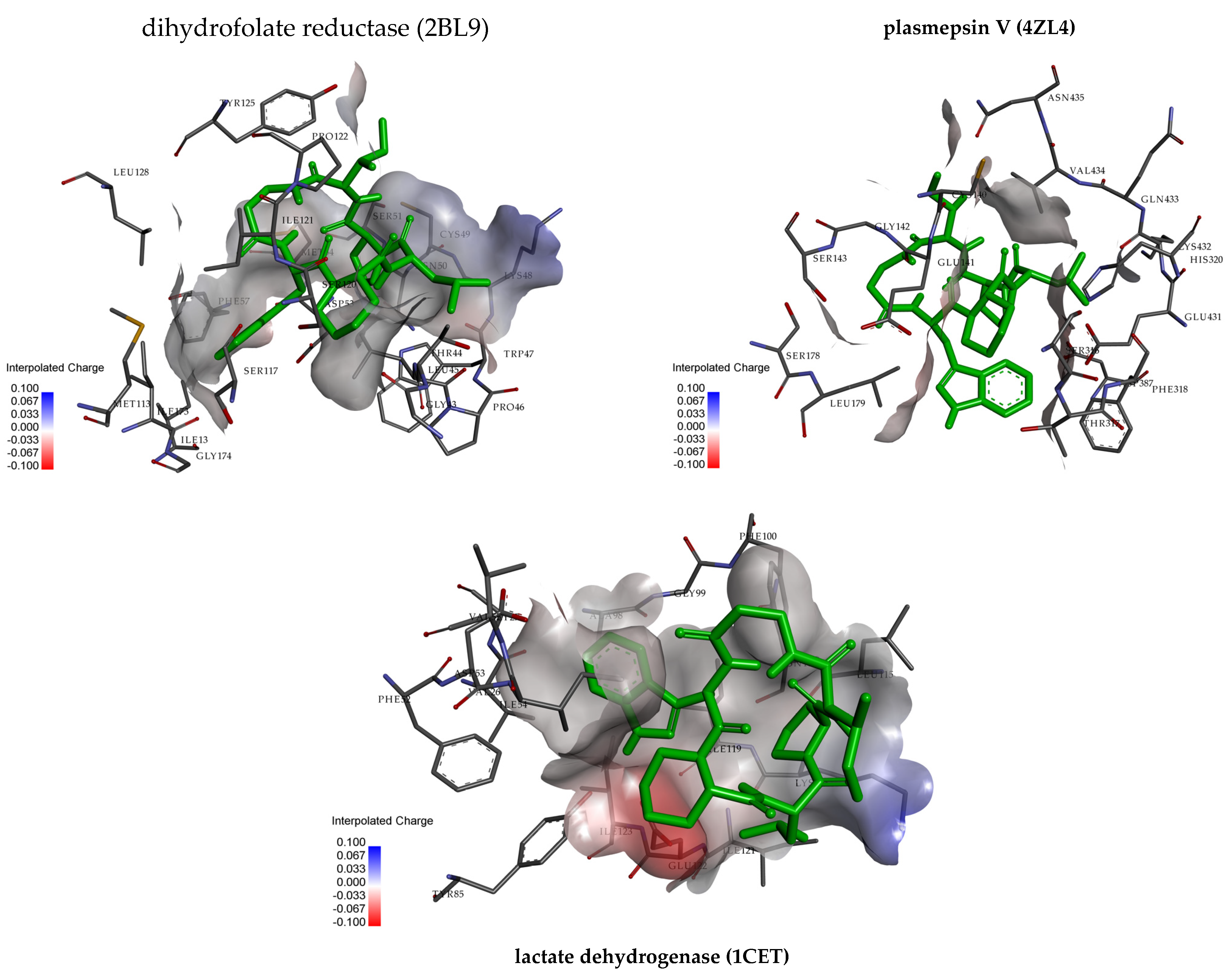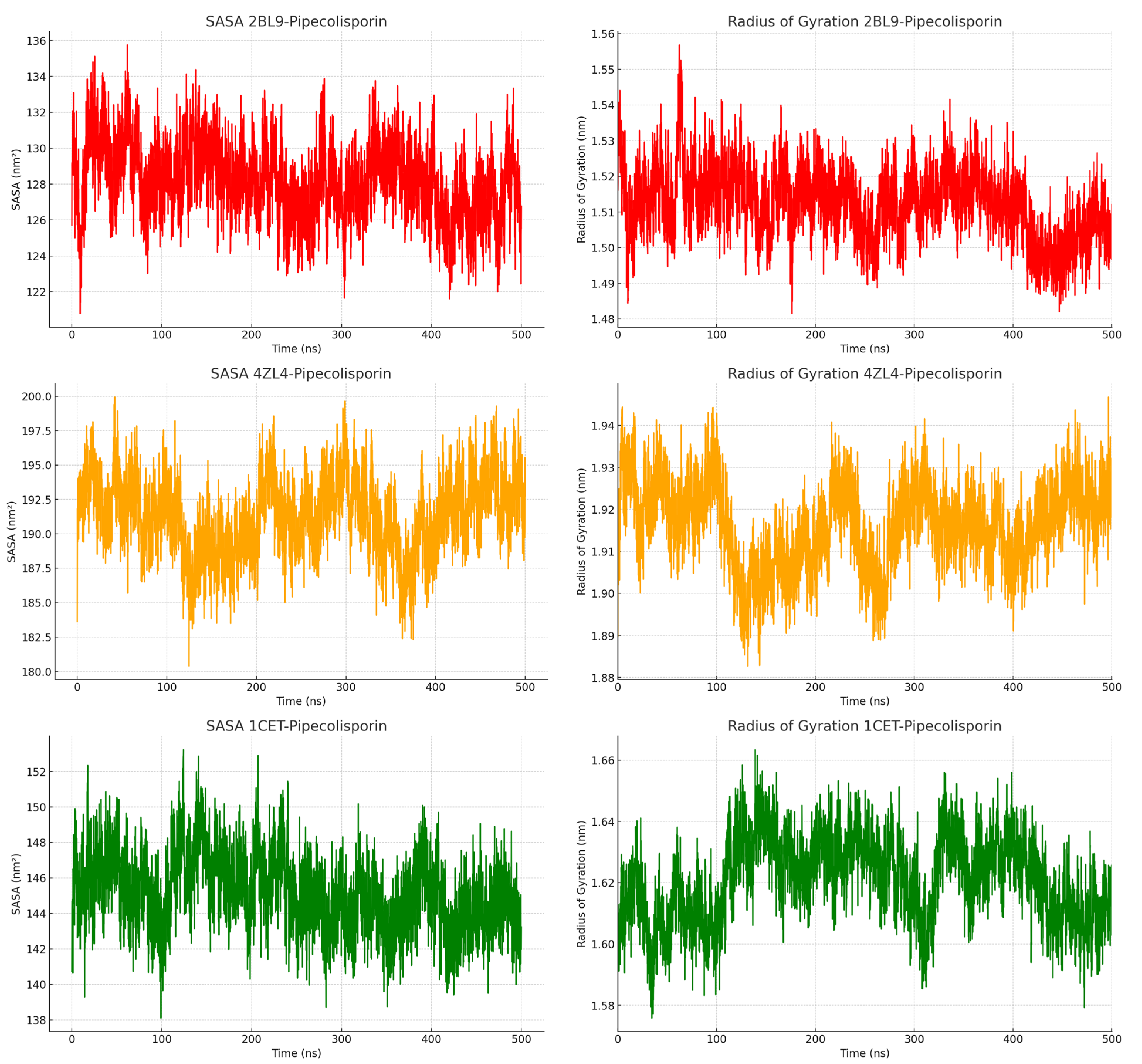Synthesis, Antimalarial Activity and Molecular Dynamics Studies of Pipecolisporin: A Novel Cyclic Hexapeptide with Potent Therapeutic Potential
Abstract
1. Introduction
2. Results
2.1. Synthesis of Pipecolisporin Peptide
2.2. Characterization and Purification of Pipecolisporin Peptide
2.3. Antimalarial Activity Evaluation of Pipecolisporin Peptide
2.4. Pipecolisporin Modeling Study
2.5. Frontiers Molecular Orbital (FMO) Analysis and Reactivity Indicators of Pipecolisporin
2.6. Pipecolisporin Structure and Activity Relationship (SAR) Identification
2.7. Molecular Docking Studies
2.8. Pharmacokinetic and Pharmacodynamics Evaluation
2.9. Toxicity Profiles Investigation
2.10. Molecular Dynamic Simulations
3. Discussion
4. Materials and Methods
4.1. Tools and Materials
4.2. Synthesis of Pipecolisporin Linear Peptide
4.3. Cyclization of Pipecolisporin Linear Peptide
4.4. Antimalarial Activity Assay of Pipecolisporin Peptide
4.5. Computational Analysis of Pipecolisporin Peptide
4.5.1. Density Functional Theory (DFT) Methods
4.5.2. Molecular Docking Methods
4.5.3. Pharmacokinetic and Pharmacodynamics Evaluations
4.5.4. Molecular Dynamic Simulation Methods
5. Conclusions
Supplementary Materials
Author Contributions
Funding
Institutional Review Board Statement
Informed Consent Statement
Data Availability Statement
Acknowledgments
Conflicts of Interest
References
- Venkatesan, P. The 2023 WHO World Malaria Report. Lancet Microbe 2024, 5, e214. [Google Scholar] [CrossRef] [PubMed]
- Milner, D.A. Malaria pathogenesis. Cold Spring Harb. Perspect. Med. 2018, 8, a025569. [Google Scholar] [CrossRef]
- Kakuru, A.; Jagannathan, P.; Muhindo, M.K.; Natureeba, P.; Awori, P.; Nakalembe, M.; Opira, B.; Olwoch, P.; Ategeka, J.; Nayebare, P.; et al. Dihydroartemisinin–Piperaquine for the Prevention of Malaria in Pregnancy. N. Engl. J. Med. 2016, 374, 928–939. [Google Scholar] [CrossRef] [PubMed]
- Pérez-Picaso, L.; Velasco-Bejarano, B.; Aguilar-Guadarrama, A.B.; Argotte-Ramos, R.; Rios, M.Y. Antimalarial activity of ultra-short peptides. Molecules 2009, 14, 5103–5114. [Google Scholar] [CrossRef]
- Kapishnikov, S.; Leiserowitz, L.; Yang, Y.; Cloetens, P.; Pereiro, E.; Awamu Ndonglack, F.; Matuschewski, K.; Als-Nielsen, J. Biochemistry of malaria parasite infected red blood cells by X-ray microscopy. Sci. Rep. 2017, 7, 802. [Google Scholar] [CrossRef] [PubMed]
- Dhawan, S.; Dua, M.; Chishti, A.H.; Hanspal, M. Ankyrin peptide blocks falcipain-2-mediated malaria parasite release from red blood cells. J. Biol. Chem. 2003, 278, 30180–30186. [Google Scholar] [CrossRef] [PubMed]
- Fernández-Pastor, I.; González-Menéndez, V.; Annang, F.; Toro, C.; Mackenzie, T.A.; Bosch-Navarrete, C.; Genilloud, O.; Reyes, F. Pipecolisporin, a novel cyclic peptide with antimalarial and antitrypanosome activities from a wheat endophytic Nigrospora oryzae. Pharmaceuticals 2021, 14, 268. [Google Scholar] [CrossRef] [PubMed]
- Xu, P.; Andreasen, P.A.; Huang, M. Structural principles in the development of cyclic peptidic enzyme inhibitors. Int. J. Biol. Sci. 2017, 13, 1222–1233. [Google Scholar] [CrossRef]
- Costa, L.; Sousa, E.; Fernandes, C. Cyclic Peptides in Pipeline: What Future for These Great Molecules? Pharmaceuticals 2023, 16, 996. [Google Scholar] [CrossRef]
- Dembitsky, V.M. Hydrobiological Aspects of Fatty Acids: Unique, Rare, and Unusual Fatty Acids Incorporated into Linear and Cyclic Lipopeptides and Their Biological Activity. Hydrobiology 2022, 1, 331–432. [Google Scholar] [CrossRef]
- Kim, S.J.; McAlpine, S.R. Solid phase versus solution phase synthesis of heterocyclic macrocycles. Molecules 2013, 18, 1111–1121. [Google Scholar] [CrossRef] [PubMed]
- Muhajir, M.I.; Hardianto, A.; Al-Anshori, J.; Sumiarsa, D.; Mayanti, T.; Nurlelasari; Harneti, D.; Hidayat, A.T.; Maharani, R. Total Synthesis of Nocardiotide A by Using a Combination of Solid-and Solution-Phase Methods. ChemistrySelect 2021, 6, 12941–12946. [Google Scholar] [CrossRef]
- Maharani, R.; Yayat, H.N.A.; Hidayat, A.T.; Al Anshori, J.; Sumiarsa, D.; Farabi, K.; Mayanti, T.; Nurlelasari; Harneti, D.; Supratman, U. Synthesis of a Cyclooctapeptide, Cyclopurpuracin, and Evaluation of Its Antimicrobial Activity. Molecules 2023, 28, 4779. [Google Scholar] [CrossRef]
- Sarojini, V.; Cameron, A.J.; Varnava, K.G.; Denny, W.A.; Sanjayan, G. Cyclic Tetrapeptides from Nature and Design: A Review of Synthetic Methodologies, Structure, and Function. Chem. Rev. 2019, 119, 10318–10359. [Google Scholar] [CrossRef] [PubMed]
- Vyas, V.K.; Bhati, S.; Patel, S.; Ghate, M. Structure- and ligand-based drug design methods for the modeling of antimalarial agents: A review of updates from 2012 onwards. J. Biomol. Struct. Dyn. 2022, 40, 10481–10506. [Google Scholar] [CrossRef] [PubMed]
- Butler, J.H.; Painter, H.J.; Bremers, E.K.; Krai, P.; Llinás, M.; Cassera, M.B. Cripowellins Pause Plasmodium falciparum Intraerythrocytic Development at the Ring Stage. Molecules 2023, 28, 2600. [Google Scholar] [CrossRef]
- Takechi-Haraya, Y.; Ohgita, T.; Kotani, M.; Kono, H.; Saito, C.; Tamagaki-Asahina, H.; Nishitsuji, K.; Uchimura, K.; Sato, T.; Kawano, R.; et al. Effect of hydrophobic moment on membrane interaction and cell penetration of apolipoprotein E-derived arginine-rich amphipathic α-helical peptides. Sci. Rep. 2022, 12, 4959. [Google Scholar] [CrossRef]
- Gedeon, J.; Schmidt, J.; Hodgson, M.J.P.; Wetherell, J.; Benavides-Riveros, C.L.; Marques, M.A.L. Machine learning the derivative discontinuity of density-functional theory. Mach. Learn. Sci. Technol. 2022, 3, 015011. [Google Scholar] [CrossRef]
- Juma, J.M.; Vuai, S.A.H. Computational studies of the thermodynamic properties, and global and reactivity descriptors of fluorescein dye derivatives in acetonitrile using density functional theory. J. Chem. Res. 2021, 45, 800–805. [Google Scholar] [CrossRef]
- Tripathi, P.; Ghosh, S.; Nath Talapatra, S. Bioavailability prediction of phytochemicals present in Calotropis procera (Aiton) R. Br. by using Swiss-ADME tool. World Sci. News 2019, 131, 147–163. [Google Scholar]
- Lu, X.; Huang, J. A thermodynamic investigation of amyloid precursor protein processing by human γ-secretase. Commun. Biol. 2022, 5, 837. [Google Scholar] [CrossRef]
- Nurisyah; Ramadhan, D.S.F.; Dewi, R.; Asikin, A.; Daswi, D.R.; Adam, A.; Chaerunnimah; Sunarto; Rafika; Artati; et al. Targeting EGFR allosteric site with marine-natural products of Clathria sp.: A computational approach. Curr. Res. Struct. Biol. 2024, 7, 100125. [Google Scholar] [CrossRef] [PubMed]
- Abdolmaleki, A.; Ghasemi, J.; Ghasemi, F. Computer Aided Drug Design for Multi-Target Drug Design: SAR/QSAR, Molecular Docking and Pharmacophore Methods. Curr. Drug Targets 2017, 18, 556–575. [Google Scholar] [CrossRef] [PubMed]
- Karami, T.K.; Hailu, S.; Feng, S.; Graham, R.; Gukasyan, H.J. Eyes on Lipinski’s Rule of Five: A New “Rule of Thumb” for Physicochemical Design Space of Ophthalmic Drugs. J. Ocul. Pharmacol. Ther. 2022, 38, 43–55. [Google Scholar] [CrossRef] [PubMed]
- Sangeetha, K.G.; Aravindakshan, K.K. Experimental, insilico, DFT studies of novel compound 2-{2-[(3,4-dimethoxyphenyl)methylidene]hydrazinecarbonothioyl}-N-methyl-N-phenylhydrazine-1-carbothioamide. Results Chem. 2022, 4, 100534. [Google Scholar] [CrossRef]
- Yeni, Y.; Rachmania, R.A. The Prediction of Pharmacokinetic Properties of Compounds in Hemigraphis alternata (Burm.F.) T. Ander Leaves Using pkCSM. Indones. J. Chem. 2022, 22, 1081–1089. [Google Scholar] [CrossRef]
- Suhandi, C.; Alfathonah, S.S.; Hasanah, A.N. Potency of Xanthone Derivatives from Garcinia mangostana L. for COVID-19 Treatment through Angiotensin-Converting Enzyme 2 and Main Protease Blockade: A Computational Study. Molecules 2023, 28, 5187. [Google Scholar] [CrossRef]
- Anggoro, B.; Kumara, D.; Angelina, D.; Ikawati, M. Citrus Flavonoids from Citrus reticulata Peels Potentially Target an Autophagy Modulator, MAP1LC3A, in Breast Cancer. Indones. J. Cancer Chemoprev. 2021, 12, 114–122. [Google Scholar] [CrossRef]
- Hikmawati, D.; Fakih, T.M.; Sutedja, E.; Dwiyana, R.F.; Ramadhan, D.S.F. Pharmacophore-guided virtual screening and dynamic simulation of Kallikrein-5 inhibitor: Discovery of potential molecules for rosacea therapy. Inform. Med. Unlocked 2022, 28, 100844. [Google Scholar] [CrossRef]
- Forli, S.; Huey, R.; Pique, M.E.; Sanner, M.F.; Goodsell, D.S.; Olson, A.J. Computational protein-ligand docking and virtual drug screening with the AutoDock suite. Nat. Protoc. 2016, 11, 905–919. [Google Scholar] [CrossRef] [PubMed]
- Henriksen, J.R.; Etzerodt, T.; Gjetting, T.; Andresen, T.L. Side chain hydrophobicity modulates therapeutic activity and membrane selectivity of antimicrobial peptide mastoparan-X. PLoS ONE 2014, 9, e91007. [Google Scholar] [CrossRef] [PubMed]
- Schifano, N.P.; Caputo, G.A. Investigation of the Role of Hydrophobic Amino Acids on the Structure–Activity Relationship in the Antimicrobial Venom Peptide Ponericin L1. J. Membr. Biol. 2022, 255, 537–551. [Google Scholar] [CrossRef] [PubMed]
- Li, Q.; Zhao, Z.; Zhou, D.; Chen, Y.; Hong, W.; Cao, L.; Yang, J.; Zhang, Y.; Shi, W.; Cao, Z.; et al. Virucidal activity of a scorpion venom peptide variant mucroporin-M1 against measles, SARS-CoV and influenza H5N1 viruses. Peptides 2011, 32, 1518–1525. [Google Scholar] [CrossRef]
- Kurniaty, N.; Maharani, R.; Hidayat, A.T.; Supratman, U. An Overview on Antimalarial Peptides: Natural Sources, Synthetic Methodology and Biological Properties. Molecules 2023, 28, 7778. [Google Scholar] [CrossRef]
- Ihsan, A.B.; Nargis, M.; Koyama, Y. Effects of the hydrophilic-lipophilic balance of alternating peptides on self-assembly and thermo-responsive behaviors. Int. J. Mol. Sci. 2019, 20, 4604. [Google Scholar] [CrossRef]
- Fetse, J.; Zhao, Z.; Liu, H.; Mamani, U.F.; Mustafa, B.; Adhikary, P.; Ibrahim, M.; Liu, Y.; Patel, P.; Nakhjiri, M.; et al. Discovery of Cyclic Peptide Inhibitors Targeting PD-L1 for Cancer Immunotherapy. J. Med. Chem. 2022, 65, 12002–12013. [Google Scholar] [CrossRef]
- Caro, F.; Miller, M.G.; DeRisi, J.L. Plate-based transfection and culturing technique for genetic manipulation of Plasmodium falciparum. Malar. J. 2012, 11, 22. [Google Scholar] [CrossRef] [PubMed]
- Crispim, M.; Verdaguer, I.B.; Silva, S.F.; Katzin, A.M. Suitability of methods for Plasmodium falciparum cultivation in atmospheric air. Mem. Inst. Oswaldo Cruz 2022, 117, e210331. [Google Scholar] [CrossRef] [PubMed]
- Ryan, S.J.; Lippi, C.A.; Villena, O.C.; Singh, A.; Murdock, C.C.; Johnson, L.R. Mapping current and future thermal limits to suitability for malaria transmission by the invasive mosquito Anopheles stephensi. Malar. J. 2023, 22, 104. [Google Scholar] [CrossRef] [PubMed]
- Mavrevski, R.; Traykov, M.; Trenchev, I.; Trencheva, M. Approaches to modeling of biological experimental data with Graphpad prism software. WSEAS Trans. Syst. Control 2018, 13, 242–247. [Google Scholar]
- Frisch, M.J.; Trucks, G.W.; Schlegel, H.B.; Scuseria, G.E.; Robb, M.A.; Cheeseman, J.R.; Scalmani, G.; Barone, V.; Mennucci, B.; Petersson, G.A.; et al. Gaussian16(Revision A.03); Gaussian Inc.: Wallingford, CT, USA, 2016. [Google Scholar]
- Kongsaeree, P.; Khongsuk, P.; Leartsakulpanich, U.; Chitnumsub, P.; Tarnchompoo, B.; Walkinshaw, M.D.; Yuthavong, Y. Crystal structure of dihydrofolate reductase from Plasmodium vivax: Pyrimethamine displacement linked with mutation-induced resistance. Proc. Natl. Acad. Sci. USA 2005, 102, 13046–13051. [Google Scholar] [CrossRef] [PubMed]
- Hodder, A.N.; Sleebs, B.E.; Czabotar, P.E.; Gazdik, M.; Xu, Y.; O’Neill, M.T.; Lopaticki, S.; Nebl, T.; Triglia, T.; Smith, B.J.; et al. Structural basis for plasmepsin v inhibition that blocks export of malaria proteins to human erythrocytes. Nat. Struct. Mol. Biol. 2015, 22, 590–596. [Google Scholar] [CrossRef] [PubMed]
- Read, J.A.; Wilkinson, K.W.; Tranter, R.; Sessions, R.B.; Brady, R.L. Chloroquine Binds in the Cofactor Binding Site of Plasmodium falciparum Lactate Dehydrogenase. J. Biol. Chem. 1999, 274, 10213–10218. [Google Scholar] [CrossRef]
- Jiroušková, Z.; Vařeková, R.S.; Vaněk, J.; Koča, J. Electronegativity equalization method: Parameterization and validation for organic molecules using the Merz-Kollman-Singh charge distribution scheme. J. Comput. Chem. 2009, 30, 1174–1178. [Google Scholar] [CrossRef] [PubMed]
- Daina, A.; Michielin, O.; Zoete, V. SwissADME: A free web tool to evaluate pharmacokinetics, drug-likeness and medicinal chemistry friendliness of small molecules. Sci. Rep. 2017, 7, 42717. [Google Scholar] [CrossRef] [PubMed]
- Kim, S.; Chen, J.; Cheng, T.; Gindulyte, A.; He, J.; He, S.; Li, Q.; Shoemaker, B.A.; Thiessen, P.A.; Yu, B.; et al. PubChem 2023 update. Nucleic Acids Res. 2023, 51, D1373–D1380. [Google Scholar] [CrossRef] [PubMed]
- Abraham, M.J.; Murtola, T.; Schulz, R.; Páll, S.; Smith, J.C.; Hess, B.; Lindahl, E. GROMACS: High performance molecular simulations through multi-level parallelism from laptops to supercomputers. SoftwareX 2015, 1, 19–25. [Google Scholar] [CrossRef]
- Pronk, S.; Páll, S.; Schulz, R.; Larsson, P.; Bjelkmar, P.; Apostolov, R.; Shirts, M.R.; Smith, J.C.; Kasson, P.M.; Van Der Spoel, D.; et al. GROMACS 4.5: A high-throughput and highly parallel open source molecular simulation toolkit. Bioinformatics 2013, 29, 845–854. [Google Scholar] [CrossRef]
- Van Der Spoel, D.; Lindahl, E.; Hess, B.; Groenhof, G.; Mark, A.E.; Berendsen, H.J.C. GROMACS: Fast, flexible, and free. J. Comput. Chem. 2005, 26, 1701–1718. [Google Scholar] [CrossRef]
- Zhang, H.; Jiang, Y.; Cui, Z.; Yin, C. Force Field Benchmark of Amino Acids. 2. Partition Coefficients Between Water and Organic Solvents. J. Chem. Inf. Model. 2018, 58, 1669–1681. [Google Scholar] [CrossRef] [PubMed]
- Li, Z.; Xiong, S.; Sievers, C.; Hu, Y.; Fan, Z.; Wei, N.; Bao, H.; Chen, S.; Donadio, D.; Ala-Nissila, T. Influence of thermostatting on nonequilibrium molecular dynamics simulations of heat conduction in solids. J. Chem. Phys. 2019, 151, 234105. [Google Scholar] [CrossRef] [PubMed]
- Brańka, A.C. Nosé-Hoover chain method for nonequilibrium molecular dynamics simulation. Phys. Rev. E 2000, 61, 4769. [Google Scholar] [CrossRef] [PubMed]
- Kumari, R.; Kumar, R.; Consortium, O.S.D.D.; Lynn, A. g_mmpbsa—A GROMACS tool for MM-PBSA and its optimization for high-throughput binding energy calculations. J. Chem. Inf. Model. 2014, 54, 1951–1962. [Google Scholar] [CrossRef] [PubMed]
- Wang, C.; Greene, D.; Xiao, L.; Qi, R.; Luo, R. Recent developments and applications of the MMPBSA method. Front. Mol. Biosci. 2018, 4, 87. [Google Scholar] [CrossRef] [PubMed]






| Amino Acid | Pipecolisporin Product Synthesis (CD3OD, 700 MHz) | Pipecolisporin Natural Product (DMSO-d6, 500 MHz) [6] | ||
|---|---|---|---|---|
| 1H δH (ppm), m, J (Hz) | 13C (ppm) | 1H δH (ppm), m, J (Hz) | 13C (ppm) | |
| Pro CO 1 2 3 3e 4 | 3.99–4.00 (m) 2.36–2.38 (m) 2.13–2.14 (m), 1.85–1.86 (m) 3.78–3.80 (m) | 173.1 62.9 29.2 25.4 46.9 | 3.99, (m) 2.19 (m), 1.77 (m) 1.99 (m), 1.84 (m) 3.72 (m), 3.56 (m) | 171.8, C 62.9, CH 29.4, CH2 25.7, CH2 47.3, CH2 |
| Ile CO NH amide 1 2 3 4 2-Me | 6.59, d, 8.61 4.22–4.23 (m) 2.01–2.03 (m) 1.30–1.33 (m) 0.80–0.81 (m) 0.81–0.82 (m) | 172.5 57.8 36.9 24.5 10.7 14.8 | 6.47, d, 8.0 4.01 (m) 1.91 (m) 1.30 (m) 0.82 (m) 0.81 (m) | 171.2, C 57.5, CH 37.0, CH 24.7, CH2 12.1, CH3 16.2, CH3 |
| β–Ala CO NH amide 1 2 | 6.59, d, 8.61 2.55–2.56 (m) 3.89–3.90 (m) | 171.4 34.8 34.0 | 7.05 (m) 2.43 (m) 3.71 (m) | 171.0, C 35.2, CH2 35.0, CH3 |
| Trp CO NH amide 1 2 3 4 NH 5 6 7 8 9 10 | 8.47, s 4.68–4.67 (m) 3.20–3.31 (m), 3.18–3.20 (m) 7.37, d, J = 6 Hz 7.44–7.45 (m) 7.13–7.14 (m) 7.02–7.03 (m) 7.57 (d, J = 6 Hz) | 171.3 51.4 27.2 108.2 123.8 136.7 118.9 121.4 111.1 118.0 127.4 | 8.56, d, 8.9 4.49 (m) 3.06, (d), 14.8 3.17, (dd), 14.8, 4.1 7.29, d, 2.0 11.00, (bs) 7.34, d, 8,1 7.06 (m) 6.97 (m) 7.44 (m), 8.0 | 170.9, C 51.8, CH 27.6, CH2 108,9, C 125.0, CH 136.7, C 118.7, CH 121.7, CH 108.9, CH 118.9, CH 127.7, C |
| Pipe CO 1 2 3 4 5 | 3.94–3.95 (m) 1.43–1.44 (m) 0.98–0.99 (m) 1.18–1.20 (m) 3.26–3.28 (m) | 171.0 56.9 20.13 19.22 23.6 39.8 | 3.66 (m) 1.45 (m) 0.99 (m) 1.25 (m) 3.32 (m) | 169.6, C 56.7, CH 23.6, CH2 20.7, CH 23.9, CH2 39.4, CH2 |
| Leu CO NH amide 1 2 3 4 4’ | 8.47, s 4.45–4.46 (m) 1.86–1.87 (m) 1.70–1.72 (m) 0.81–0.82 (m) 0.89–0.91 (m) | 173.3 50.3 38.5 22.4 10.1 23.3 | 8.95, d, 8.5 4.53 (m) 1.85 (m) 1.62 (m) 0.81 (m) 0.90 (m) | 173.5, C 50.3, CH 38.3, CH2 25.2, CH 20.6, CH3 23.9, CH3 |
| Compound | Target Receptor | Binding Affinity | Inhibition Constant | Amino Acid Interaction | Category |
|---|---|---|---|---|---|
| Pipecolisporin | dihydrofolate reductase (2BL9) | −10.26 kcal/mol | 29.90 nM (nanomolar) | A:PHE57 A:PHE57 A:LEU45 A:CYS49 A:LEU45 A:MET54 A:LEU45 A:ILE173 | Hydrophobic Hydrophobic Hydrophobic Hydrophobic Hydrophobic Hydrophobic Hydrophobic Hydrophobic |
| plasmepsin V (4ZL4) | −5.38 kcal/mol | 113.76 uM (micromolar) | A:GLU141:O A:LYS432 A:VAL434 A:VAL434 A:VAL434 A:LEU179 | Hydrogen Bond Hydrophobic Hydrophobic Hydrophobic Hydrophobic Hydrophobic | |
| lactate dehydrogenase (1CET) | −6.59 kcal/mol | 14.81 uM (micromolar) | A:TYR85:OH A:GLU122:OE2 A:ILE54:CG2 A:ILE54:CD1 A:ILE54 A:LYS118 A:ILE119 A:LYS118 A:PHE100 A:ILE54 A:ILE119 A:ALA98 A:ILE119 | Hydrogen Bond Hydrogen Bond Hydrophobic Hydrophobic Hydrophobic Hydrophobic Hydrophobic Hydrophobic Hydrophobic Hydrophobic Hydrophobic Hydrophobic Hydrophobic |
| Compound | Target Receptor | Van der Waal Energy | Electrostatic Energy | Polar Solvation Energy | SASA Energy | Binding Energy |
|---|---|---|---|---|---|---|
| Pipecolisporin | dihydrofolate reductase (2BL9) | −222.699 kJ/mol | −21.963 kJ/mol | 150.384 kJ/mol | −26.109 kJ/mol | −120.386 kJ/mol |
| plasmepsin V (4ZL4) | −128.318 kJ/mol | −28.779 kJ/mol | 85.611 kJ/mol | −16.906 kJ/mol | −88.392 kJ/mol | |
| lactate dehydrogenase (1CET) | −141.450 kJ/mol | −14.199 kJ/mol | 78.001 kJ/mol | −16.996 kJ/mol | −94.644 kJ/mol |
Disclaimer/Publisher’s Note: The statements, opinions and data contained in all publications are solely those of the individual author(s) and contributor(s) and not of MDPI and/or the editor(s). MDPI and/or the editor(s) disclaim responsibility for any injury to people or property resulting from any ideas, methods, instructions or products referred to in the content. |
© 2025 by the authors. Licensee MDPI, Basel, Switzerland. This article is an open access article distributed under the terms and conditions of the Creative Commons Attribution (CC BY) license (https://creativecommons.org/licenses/by/4.0/).
Share and Cite
Kurniaty, N.; Fakih, T.M.; Maharani, R.; Supratman, U.; Hidayat, A.T.; Bakar, N.A.; Wei, X. Synthesis, Antimalarial Activity and Molecular Dynamics Studies of Pipecolisporin: A Novel Cyclic Hexapeptide with Potent Therapeutic Potential. Molecules 2025, 30, 304. https://doi.org/10.3390/molecules30020304
Kurniaty N, Fakih TM, Maharani R, Supratman U, Hidayat AT, Bakar NA, Wei X. Synthesis, Antimalarial Activity and Molecular Dynamics Studies of Pipecolisporin: A Novel Cyclic Hexapeptide with Potent Therapeutic Potential. Molecules. 2025; 30(2):304. https://doi.org/10.3390/molecules30020304
Chicago/Turabian StyleKurniaty, Nety, Taufik Muhammad Fakih, Rani Maharani, Unang Supratman, Ace Tatang Hidayat, Nurhidanatasha Abu Bakar, and Xiaoshuang Wei. 2025. "Synthesis, Antimalarial Activity and Molecular Dynamics Studies of Pipecolisporin: A Novel Cyclic Hexapeptide with Potent Therapeutic Potential" Molecules 30, no. 2: 304. https://doi.org/10.3390/molecules30020304
APA StyleKurniaty, N., Fakih, T. M., Maharani, R., Supratman, U., Hidayat, A. T., Bakar, N. A., & Wei, X. (2025). Synthesis, Antimalarial Activity and Molecular Dynamics Studies of Pipecolisporin: A Novel Cyclic Hexapeptide with Potent Therapeutic Potential. Molecules, 30(2), 304. https://doi.org/10.3390/molecules30020304






